IDENTIFICATION OF THE OPTIMAL HIIT PROTOCOL FOR FATIGUE RESISTANCE IN ADOLESCENT ATHLETES: A RANDOMIZED CONTROLLED TRIAL
Abstract
The combat sports athletes developed great gains in both muscular function and fatigue resistance by utilizing high-intensity interval training (HIIT). However, it has not been investigated fully whether different work-to-rest ratios of HIIT show the effectiveness on muscle function in adolescent athletes. The purpose of the study was to compare different work-to-rest ratios by applying different rest times in response to the identical work time during HIIT on muscle function in adolescent taekwondo athletes. Forty-seven adolescent male taekwondo athletes (mean age: 16.7±0.8 years) were randomly assigned to the control group (n=11) vs. three HIIT groups by work-to-rest ratios; (1) 1:2 [30s:60s] (n=12), (2) 1:4 [30s:120s] (n=12), and (3) 1:8 [30s:240s] (n=12). All groups completed 10 experimental sessions over four weeks, while the control group maintained their regular taekwondo training. Muscular functions were measured by assessing isokinetic muscle strength and endurance of the knee extensor and flexor. The participants performed three sets of twenty maximal extension and flexion contractions at 120°s-1 with a 1-min interval between the sets for fatigue resistance. Blood samples were collected to measure free-testosterone, cortisol, creatine kinase, and urea as stress-to-recovery indicators. A positive effect on improving muscle fatigue resistance was observed at the first set of assessments in the HIIT with 1:4 (Δ10.2%, p<.05) and 1:8 groups (Δ8.6%, p<.05). Additionally, the 1:4 group exhibited fatigue resistance improvement in the second set (Δ7.7%, p<.01) without any changes of stress-to-recovery indicators, while the other groups did not show any improvement. The 30s all-out work with 120s rest time, lasting over a brief 4-week period, improved participants’ fatigue resistance. A certain amount of rest time between high-intense movements is required to optimize muscle development in adolescent athletes compared with insufficient rest time.
Key words: HIIT, muscle function, stress-to-recovery indicator, optimal protocol, adolescent athlete
Downloads
Published
How to Cite
Issue
Section
License

This work is licensed under a Creative Commons Attribution-NonCommercial 4.0 International License.
At Faculty of Kinesiology we recognize that access to quality research is vital to the scientific community and beyond. Kinesiology is non-profit journal and all costs of publishing and peer review process are covered by the publisher itself or other funding sources like Ministry of Science and Education of the Republic of Croatia. Full text papers are also available free of charge at http://hrcak.srce.hr/kineziologija. There are no restrictions on self archiving of any form of paper (preprint, postprint and publisher's version).
Articles are distributed under the terms of the CC BY - NC 4.0
Kinesiology does not charge any fees to authors to submit or publish articles in our journal.


